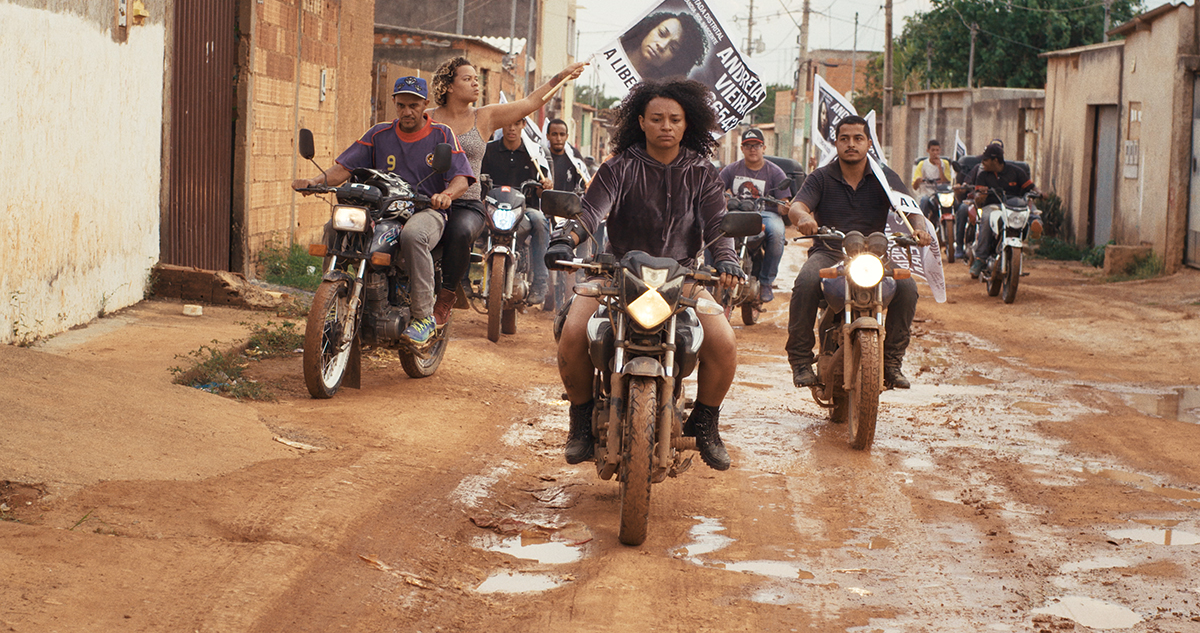In the dead of night, women gather, barrels and hoses in hand, as inky oil seeps from the ground. The oil rig responsible for bringing the gasoline to the earth’s surface clicks at a steady pace. The constant thrum of the rig sets a tempo for the work of the gasolineiras gathering the crude oil they’ll refine and sell back to their community. And it also sets the tone for the whole of Dry Ground Burning (Mato Seco em Chamas in Portuguese). The film takes elements of documentary, dystopian sci-fi, and gangster movies to make something that blurs the lines of reality and fiction — creating a movie that’s radical, queer, and unafraid to burn down expectations.
Dry Ground Burning follows half-sisters, Léa (Léa Alves Silva) and Chitara (Joana Darc Furtado). Léa has just been released from an eight-year prison sentence and decides to join forces with Chitara and her group of gasolineiras. They sell the oil they steal to an underground group of bikers, lighting up the soil to showcase the quality of the petrol. It’s a warm and harrowing image, a line of fire between the women and their customers, and a show of trust and care between the two parties.

Léa and Chitara’s favela of Sol Nascente is either overlooked or taken advantage of by the federal government, and so their technical crimes become an act of resistance: the people of Sol Nascente providing for each other in the face of an antagonistic government.
The movie built around this premise, a badass group of women who take what they want and resist Bolsonaro’s vision of Brazil through their actions and existence, is more of a slow burn than you might expect. Dry Ground Burning takes its time, letting the viewer sink into the near-future dystopia directors Joana Pimenta and Adirley Queirós have built.
Viewers looking for a fast-paced thrill ride will not find that here, but will instead get something much more complicated and compelling. There are a lot of quiet moments spent with characters doing banal tasks. We sit with Léa as she takes a long drag of her cigarette, watch as Chitara and the women work diligently to collect the oil from the ground into barrels, and ride along with Andreia Vieira as she campaigns to represent and improve the favela.

There are also moments in Dry Ground Burning that were unexpectedly electric. In one scene, we see Léa partying it up on a bus full of other women. Bodies crowd together, dancing, moving in time to the thump of the rap playing over the speakers. We’re up close with the women, but also at an arm’s length away: we might get tight shots of the women’s faces and bodies, but we never get close enough to hear a conversation, not even a line of dialogue.
And then, with a sharp cut, the party is over. It’s daytime, the bus is now full of inmates (Léa among them), and they are being dropped off at a random location. This tonal disruption and subversion of narrative expectations is one example of what makes Burning such a compelling watch. There might not be Mad Max-style setpieces (although there are nods to the aesthetics and spirit of the series) but there’s formal daring and worldbuilding that makes this alternate universe version of Brazil feel disconcertingly real.
Blurring the lines between reality and fiction can be a risky gambit. In Dry Ground Burning, it pays off for the most part, creating a radically different take on the genres and styles it pulls from. Just when you think Dry Ground Burning is going to be one thing, it opens itself up to become something completely different. Unharried and unconcerned with narrative conventions, the movie eschews the expectations a viewer might have walking in. Instead, audiences get a radical slow-burn of a film, one that’s unafraid to move at its own pace as it follows its characters through thick and thin. Dry Ground Burning is a movie worth seeking out for its audacious, subversive nature, and worth sticking around for because of its lived-in, believable feel.

